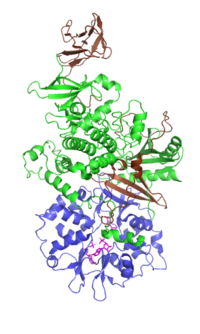
Photo from wikipedia
PGC-1α coactivator plays a decisive role in the maintenance of lipid balance via engagement in numerous metabolic processes (i.e., Krebs cycle, β-oxidation, oxidative phosphorylation and electron transport chain). It constitutes… Click to show full abstract
PGC-1α coactivator plays a decisive role in the maintenance of lipid balance via engagement in numerous metabolic processes (i.e., Krebs cycle, β-oxidation, oxidative phosphorylation and electron transport chain). It constitutes a link between fatty acids import and their complete oxidation or conversion into bioactive fractions through the coordination of both the expression and subcellular relocation of the proteins involved in fatty acid transmembrane movement. Studies on cell lines and/or animal models highlighted the existence of an upregulation of the total and mitochondrial FAT/CD36, FABPpm and FATPs content in skeletal muscle in response to PGC-1α stimulation. On the other hand, the association between PGC-1α level or activity and the fatty acids transport in the heart and adipocytes is still elusive. So far, the effects of PGC-1α on the total and sarcolemmal expression of FAT/CD36, FATP1, and FABPpm in cardiomyocytes have been shown to vary in relation to the type of PPAR that was coactivated. In brown adipose tissue (BAT) PGC-1α knockdown was linked with a decreased level of lipid metabolizing enzymes and fatty acid transporters (FAT/CD36, FABP3), whereas the results obtained for white adipose tissue (WAT) remain contradictory. Furthermore, dysregulation in lipid turnover is often associated with insulin intolerance, which suggests the coactivator's potential role as a therapeutic target.
Journal Title: Frontiers in Physiology
Year Published: 2017
Link to full text (if available)
Share on Social Media: Sign Up to like & get
recommendations!